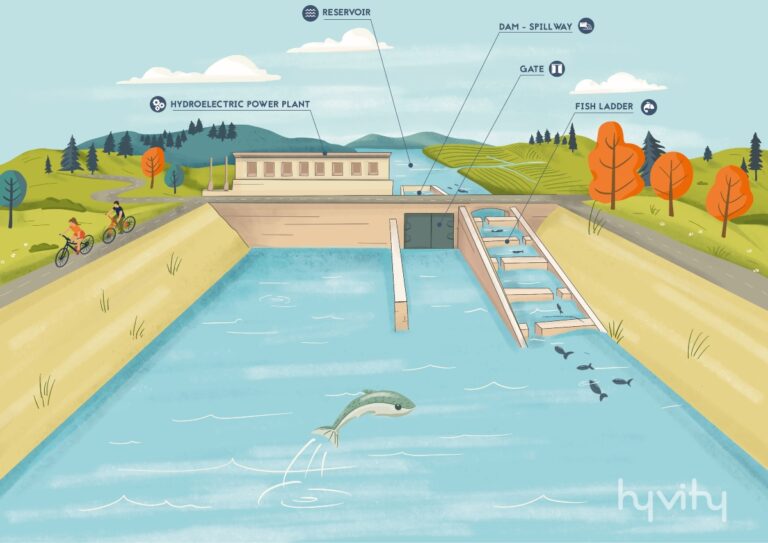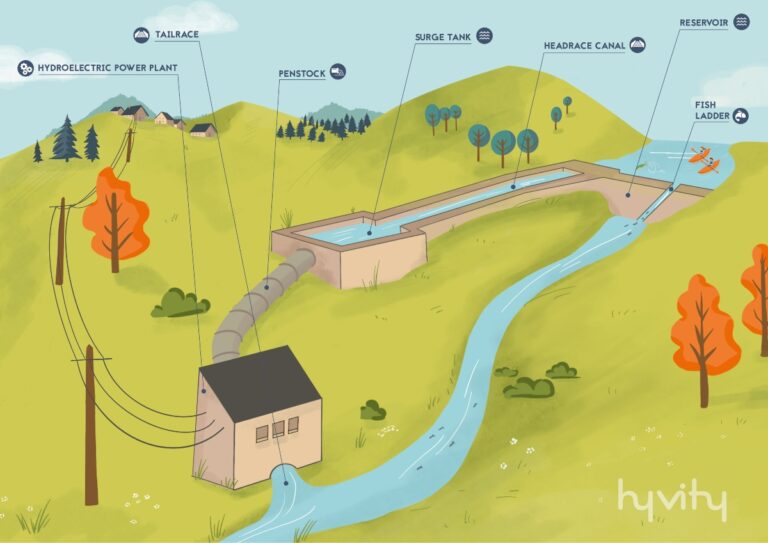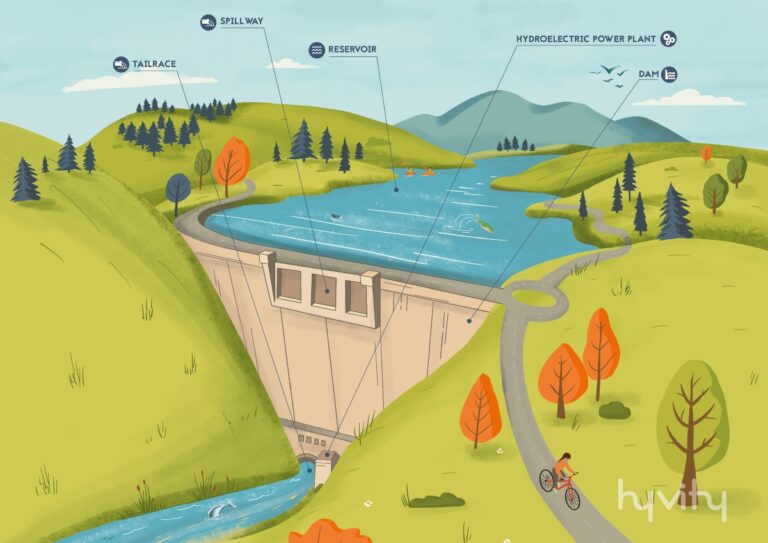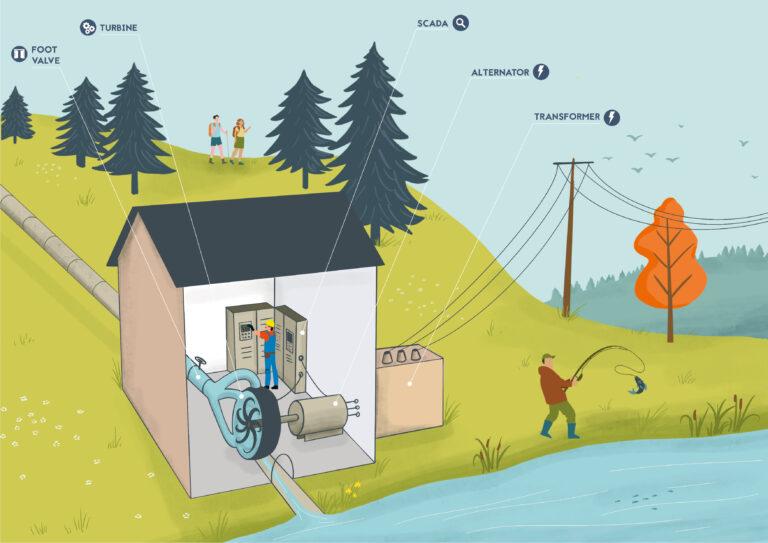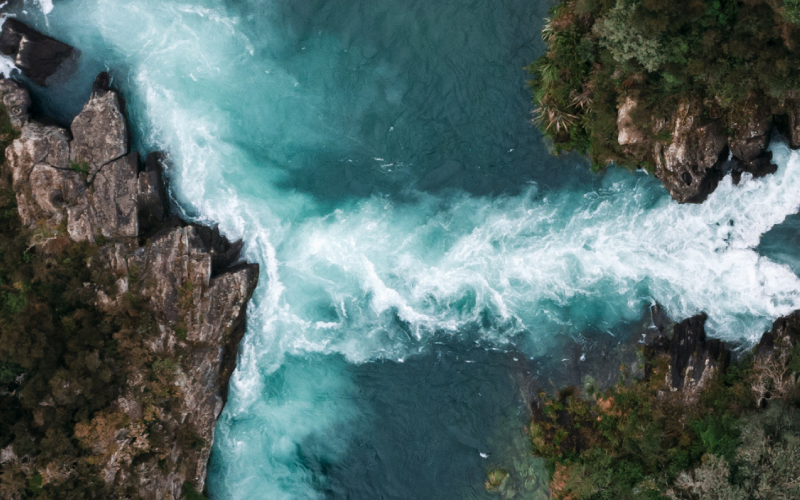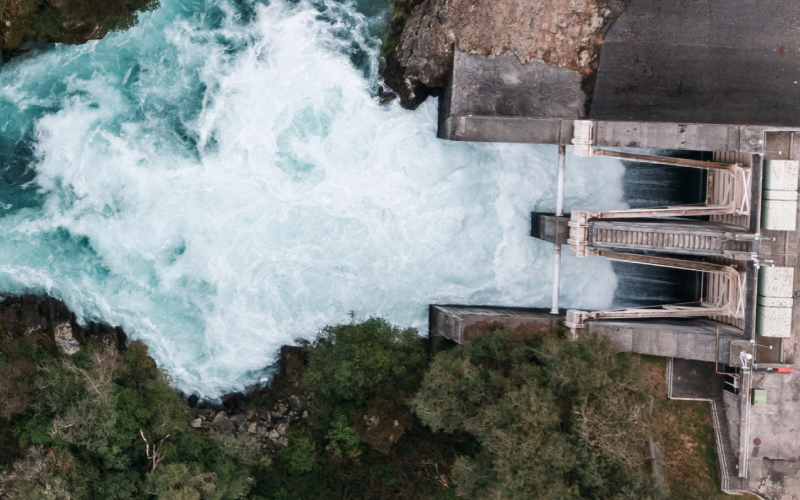
La production d'électricité
Mieux comprendre l’hydroélectricité
Fundamental principles of Hydroelectricity
Humanity has known how to use the force of water to generate mechanical energy and later, electrical energy. By integrating into the natural water cycle, a hydroelectric facility produces sustainable and renewable energy, harmonizing human skills with the forces of Nature. It transforms the gravitational energy of lakes, rivers, and tides into electricity.
These facilities are generally composed of a structure that directs water towards a production plant or stores it. The water moves a turbine coupled with an alternator. The alternator transforms the kinetic energy of rotation into electrical energy, which is then discharge into the grid. The electrical power is proportional to the height of the head and the flow rate through the turbine. A hydroelectric plant does not consume water, and every drop is returned to the river downstream unaltered.
Understanding Hydro in four Steps
It is about transforming the water’s potential energy into mechanical energy and then into electrical energy through the turbine/alternator combination.
One cubic meter of water at an altitude of 100 meters has a potential energy of 0.2725 kWh ⇒ with hydroelectricity, we can recover around 80% of this, or 0.218 kWh.
Ten cubic meters of water at an altitude of 1000 meters have a potential energy of 27.25 kWh ⇒ with hydroelectricity, about 80% of it, or 21.80 kWh, can be recovered.
Producing 1MWh is equivalent to 1 MW of power operating for one hour (not 1MW per hour).
10 MW of power operating for 10 hours equals a production of 100 MWh.
100,000 kW = 100 MW = 0.1 GW = 0.0001 TW
An average French household consumes 390 kWh per month, or 4.6 MWh per year. (Engie)
1 GWh is the average consumption of 217 households over one year.
1 TWh is the average consumption of 217,000 households over one year.
A simple calculation that varies in each country depending on household consumption.
In 2021, the world production of hydroelectricity was 4,273.8 TWh (15.1% of global electricity), mainly in China, Canada, Brazil, and the United States.
In France, 62.5 TWh were produced in 2021, accounting for 12% of French electrical production.
In Vietnam, 96 TWh were produced in 2022, accounting for 37% of the country’s electricity production.
By the end of 2020, Chile had 7 GW of installed capacity, representing 23% of the country’s production capacity.
Madagascar has an installed capacity of about 200 MW on the island, with an estimated potential of 7800 MW.
In Costa Rica, the country’s energy mix is 99.99% from renewable sources, of which 80.04% is hydroelectricity.
Different types of power plants
There are two main families of hydroelectric facilities.
Run-of-River power plants
Run-of-river power plants turbine a portion of the water flow in the river without the possibility of storage. There is generally a reserved flow that cannot be turbined, which helps to preserve the ecological continuity of watercourses.
These facilities maintain a regulation level and produce energy continuously, depending on the flow rates of the watercourses. All the water taken is immediately returned to the river. Predictable but not controllable, they provide base electricity.
By looking at the difference in altitude between the water intake upstream and the power plant downstream, we can distinguish between low-head power plants and medium to high-head power plants.
Lake and reservoir power plants
Lake power plants and reservoir power plants offer water storage capacity to adjust electricity production according to demand, with notable flexibility during consumption peaks. Reservoir power plants modulate their production on a daily or weekly basis with filling cycles less than 400 hours, while lake power plants adjust over seasonal or annual periods.
These facilities are essential for balancing and stabilizing the electrical grid, providing an appropriate response to demand variations thanks to their quick start-up capability. Their controllability improves network management by allowing flexible and efficient planning of energy resource use, reducing dependence on fossil fuels..
